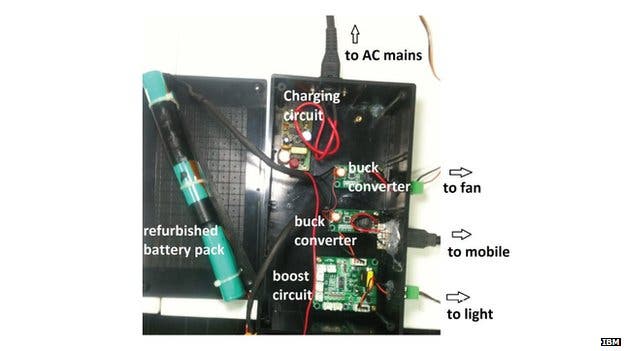An IBM team analyzed a sample of discarded batteries and found that they can still be used and can still provide benefits. They developed a device which uses re-usable Lithium Ion cells from discarded laptop battery packs to power low energy DC devices. They found that 70% of used batteries could still store enough power to keep an LED light on more than four hours a day for a year.

Forty percent of the world’s population doesn’t have access to a stable electricity source. This is especially obvious and problematic in the poorer areas of the world. At the same time, especially in the richer parts of the world, there is an increasing problem with electronic waste – especially from Lithium Ion batteries. The two problems can solve each other, as an Indian IBM team has showed.
They have developed UrJar – a play on words for energy (urja in Hindu) and box (jar). Urjar has a rechargable battery component built from pieces of discarded laptop batteries which can power an LED lightbulb, cell phone charger or other similar appliances.
“The most costly component in these systems is often the battery,” Vikas Chandan, a research scientist with IBM, who led the project told MIT’sTechnology Review. “In this case, the most expensive part of your storage solution is coming from trash.”
As any smartphone or laptop user will tell you, the more you use and then recharge your battery, the less maximum energy it can hold. This is called the charge capacity. When the charge capacity of a laptop battery pack falls below a satisfactory threshold, the user often times simply discards it and replaces it with a new battery pack (or replaces the device altogether). Researchers tested 32 laptop battery packs that were discarded by a business division of a large
multinational IT company in India and found that they still have significant residual capacity the mean value was 64%. The mean value corresponds to more than 50 Wh of capacity for the batteries tested, which is sufficient to power a 3 W LED light bulb, a 6 W DC fan and a 3.5 W mobile phone charger simultaneously, for around 4 hours.
This is definitely not groundbreaking technology – it won’t revolutionize the world as we know it, and it won’t help countries like India escape from poverty. But it’s a nice initiative to alleviate some of the issues areas without electricity are facing, as well as the growing problem of electronic waste.
“UrJar has the potential to channel e-waste towards the alleviation of energy poverty, thus simultaneously providing a sustainable solution for both problems”, the study writes.
The estimates show that this product could be producted for about $10; a survey on people who would like to use it show that they would be willing to pay up to $16 for it, so it’s quite a good value. To make things even better, IBM announced that they don’t want to make a business out of UrJar, and will instead make the blueprints available for developing countries.
Computer Aid, a UK-based charity that redistributes unwanted old technology, welcomed the initiative.
“We think that this is an excellent initiative as it is in line with our practice of reusing and refurbishing rather than recycling,” said Keith Sonnet, its chief executive. Refurbishing has definitely a more positive impact on the environment and we should encourage more companies to adopt this practice.”
Was this helpful?



